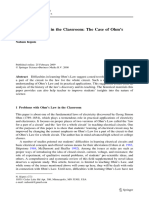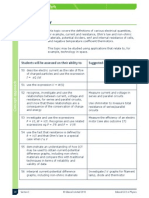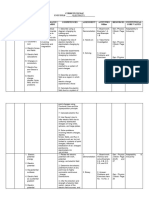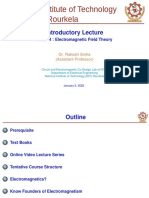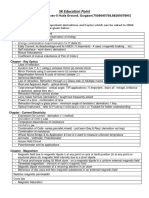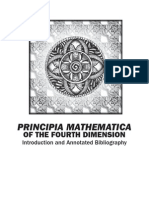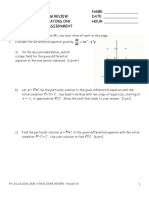6A Physics Learning Guide 2021
6A Physics Learning Guide 2021
Uploaded by
Okeiliah WrightCopyright:
Available Formats
6A Physics Learning Guide 2021
6A Physics Learning Guide 2021
Uploaded by
Okeiliah WrightCopyright
Available Formats
Share this document
Did you find this document useful?
Is this content inappropriate?
Copyright:
Available Formats
6A Physics Learning Guide 2021
6A Physics Learning Guide 2021
Uploaded by
Okeiliah WrightCopyright:
Available Formats
Glenmuir High School Classroom Standards, Expectations, & Learning Guide
6A
SUBJECT OUTLINE: PHYSICS Class Target – 65%
TEXT:
Physics for CAPE Examinations – Alec Farley and David Glover – Macmillan Education.
Calculations for A’ Level Physics – T.L. Lowe & J.F. Rounce – Nelson Thornes – 4 th Edition
Unit 2 CAPE Physics ‘Study Guide’ – Terry David , Joyce Crichlow, Dwight de Fretais, Carlos Hunte
TERM ONE (September-December)
WEEK Topic & Objectives Activities
Electrical Quantities worksheet on current electricity
discuss the terms electric current and
potential difference https://www.easyteacherworksheets
use energy considerations to .com/science/twopages-
differentiate between e.m.f and p.d electricity.html
define the terms Ampere, Coulomb,
1 (Sep 11-15) Volt, and Charge
use the equations Q =It, V= W/Q
state Ohm’s law and use V=IR to solve
problems
define electrical power and use the
equations P=IV, P=I2R and P=V2/R
to solve problems
define and use the term resistivity
2 (Sep 19 – Oct 23) use the equation R = ƿL/A to solve class activity
problems https://
explain drift velocity, use and derive www.physicstutoronline.co.uk/wp-
content/uploads/2017/10/6.-
I = nevA for electrons moving in a
Resistivity-and-Transport-equation-
metal
Edexcel.pdf
©GHS Fifth Form Learning Guide, 2020 Page 1
Glenmuir High School Classroom Standards, Expectations, & Learning Guide
6A
work problems involving resistivity and
drift velocity
Electrical Circuits
sketch IV characteristics for a group presentation on I-V
-metallic conductor characteristics
- filament lamp
- semi-conductor diode
- thermistors
3 (Oct 5- 9) sketch variation of resistance with
temperature for negative and positive
co-efficient thermistors
solve problems involving terminal p.d and
external load, given that sources of e,m.f
possess internal resistance
interpret series and parallel d.c. circuits find combined circuit resistance,
involving resistors and e.m.f elements current through resistor branches
solve problems involving series and p.d across resistors in varies
4 (Oct 12 – 16) circuits, parallel circuits and circuits
series-parallel circuits worksheet on series, parallel and
series-parallel d.c circuits
state Kirchhoff’s laws class practice questions
5 (Oct 19-23) apply Kirchhoff’s laws to given circuits worksheets
discuss the elements of a potential use Kirchhoff’s second law to
divider derive the potential divider
draw and interpret potential divider equations
circuits class practice questions
use the Wheatstone Bridge and as a project on hazards and
6 (Oct 26- 30)
means of comparing resistances applications of static electricity
Electric Fields
discuss the hazards and applications of
static electricity
©GHS Fifth Form Learning Guide, 2020 Page 2
Glenmuir High School Classroom Standards, Expectations, & Learning Guide
6A
use Coulomb’s law for the force
between charges in free space or air Coulomb’s law simulation
https://phet.colorado.edu/sims/
to solve problems { F = Q1Q2/4πεor2}
html/coulombs-law/latest/
use E = Q/4πεor2 for field strength due coulombs-law_en.html
to point charges class practice questions
use E = V/d to calculate field strength
7 (Nov 2 – 6) within a uniform electric field and
F = EQ for the force on a charged
particle within the field.
use the equation V = Q/4πεor to
calculate the electric potential due
to a point charge
Capacitor Class discussion, class activities
explain the term ‘farad’ and use C = Q/V to and worksheet
solve problems
8 (Nov 9 – 13) use the formula C =εA/d for parallel plate
capacitors
derive and use formulae for capacitors in
parallel and series to solve problems
use the energy stored in a capacitor as
W = ½ CV2, W = ½ QV and W = Q2/2C derive capacitor energy equations
to solve problems write capacitor charging and
recall and use the equations for discharging equations in a linear
capacitor charge and discharge fo rm
sketch graphs illustrating the charge plot graphs and determine the
9 (Nov 16 – 20)
and discharge of a capacitor capacitance and time
constant
of a capacitor from the
graph
gradient
Magnetic Fields
10 (Nov 23 – 27) worksheet on magnetic flux density
©GHS Fifth Form Learning Guide, 2020 Page 3
Glenmuir High School Classroom Standards, Expectations, & Learning Guide
6A
explain magnetic flux density and Tesla research and explain the terms
sketch magnetic flux patterns due to a flux density and Tesla
long straight wire, a flat circular coil
and a solenoid
use the equations B = μoI/2πr,
B = μoNI/2r and B= μonI to
calculate
the flux density for long straight
wire, a
flat circular coil and a solenoid
respectively
Magnetic Forces
explain the motor effect and use Fleming’s classwork practice questions and
left hand rule reading assignment on the
use F = BILsinθ to solve problems current
explain how the current balance can be balance, Hall effect and
the Hall
used to measure flux density
probe
predict the direction of a charge moving
in a magnetic field
11 (Nov 30 – Dec 4) use the expression F = BQVsinθ to
solve problems
solve problems involving charged
particles moving mutually perpendicular
electric and magnetic fields.
explain the HALL effect and use the
Hall probe to measure flux density
explain magnetic flux and use the
12 (Dec 7 – 11) equation Φ = BA to solve problems classwork and worksheet on
magnetic flux, calculating induced
©GHS Fifth Form Learning Guide, 2020 Page 4
Glenmuir High School Classroom Standards, Expectations, & Learning Guide
6A
explain electromagnetic induction and use
Fleming’s Right Hand Rule e.m.f and the transformer equation
state demonstrate Faraday’s law and
Lenz’s law
explain the principle of operation of the
simple transformer
use the relationship
Ns/Np =Vs/Vp = Ip/Is
review of topics done in term 1
work past paper questions on
various
13 (14 – 18)
topics done in term 1 and
perform laboratory experiments
ASSESSMENT (One of these tables must be completed for each subject)
Assignments/Projects/Tests/Examinations Marks Due Date
1. (a) Explain the terms charging by friction 20 November 6,2020
and charging by induction(aid of
diagrams)
(b) Describe three hazards and three 40
applications of static electricity.
(include well labeled diagrams)
(c) With the aid of diagrams explain the 15
production of lightning and the
function of lightning rods on buildings
©GHS Fifth Form Learning Guide, 2020 Page 5
Glenmuir High School Classroom Standards, Expectations, & Learning Guide
6A
2. Design and MAKE a working 20 December 7, 2020
d.c motor.
©GHS Fifth Form Learning Guide, 2020 Page 6
You might also like
- Unit Planner Grade 10 Physics at WorkDocument2 pagesUnit Planner Grade 10 Physics at WorkDr-Salah Jaradat100% (2)
- Stoichiometry AP Exam QuestionsDocument12 pagesStoichiometry AP Exam QuestionsAllen Jerry AriesNo ratings yet
- STE Electronics MELCsDocument4 pagesSTE Electronics MELCsNathalie Garmeles MiñosaNo ratings yet
- Class XII PhysicsDocument5 pagesClass XII PhysicsGauri ShankerNo ratings yet
- Physics - MCL For Grade 10 - T3Document4 pagesPhysics - MCL For Grade 10 - T3Keol AkumaNo ratings yet
- A Real-Space Non-Local Phase-Field Model of Ferroelectric Domain Patterns in Complex GeometriesDocument11 pagesA Real-Space Non-Local Phase-Field Model of Ferroelectric Domain Patterns in Complex GeometriesjohanNo ratings yet
- Lambert's W-Function 2023Document15 pagesLambert's W-Function 2023Fayrouz DkhichiNo ratings yet
- 23 ISC Electricity and Electronics 2026Document7 pages23 ISC Electricity and Electronics 2026asNo ratings yet
- Dichotomy Method - 2023Document11 pagesDichotomy Method - 2023Fayrouz DkhichiNo ratings yet
- Licence A SyllabusDocument8 pagesLicence A SyllabusellulphillipsmNo ratings yet
- Reed's Basic Electrotechnology For Engineers PDFDocument311 pagesReed's Basic Electrotechnology For Engineers PDFraovisam100% (2)
- Bismuth Perovskite As A Viable Alternative To PB Perovskite Solar Cells: Device Simulations To Delineate Critical Efficiency DynamicsDocument6 pagesBismuth Perovskite As A Viable Alternative To PB Perovskite Solar Cells: Device Simulations To Delineate Critical Efficiency DynamicsUsama SabirNo ratings yet
- EEE 101-OutlineDocument3 pagesEEE 101-Outlineabhishekpandit.1408No ratings yet
- Syllabus ScheduleDocument9 pagesSyllabus Schedulesatyendramishra00948No ratings yet
- A LawofPhysicsintheClassroom - TheCaseofOhms-KipnisDocument34 pagesA LawofPhysicsintheClassroom - TheCaseofOhms-KipnisdellaNo ratings yet
- Far Range Transponder Field-Physical Basis For Electrically Coupled Bidirectional Far TranspondersDocument12 pagesFar Range Transponder Field-Physical Basis For Electrically Coupled Bidirectional Far TranspondersNiklausNo ratings yet
- Cls Xii Splitup Syllabus 2022 23 PhysicsDocument12 pagesCls Xii Splitup Syllabus 2022 23 PhysicsAyush bhardwajNo ratings yet
- Introduction of General Theory of Electrical Machines Into University CoursesDocument4 pagesIntroduction of General Theory of Electrical Machines Into University CoursesDanang AjiNo ratings yet
- Mechanism Electrochemical CapacitorsDocument11 pagesMechanism Electrochemical CapacitorsAmit kumarNo ratings yet
- Course Outline (PHY 108) - Summer 2023Document3 pagesCourse Outline (PHY 108) - Summer 2023fiad.sarowarNo ratings yet
- Birla Institute of Technology and Science, Pilani: Pilani Campus AUGS/ AGSR DivisionDocument4 pagesBirla Institute of Technology and Science, Pilani: Pilani Campus AUGS/ AGSR Divisionf20220384No ratings yet
- PHS 212 - Spring 2017 - Syllabus (A & B)Document2 pagesPHS 212 - Spring 2017 - Syllabus (A & B)Fares FadlallahNo ratings yet
- Beasley 1979Document9 pagesBeasley 1979Rafik Et-TrabelsiNo ratings yet
- Electromagnetic Modeling of Superconductors With Commercial Software Possibilities With Two Vector Potential-Based FormulationsDocument9 pagesElectromagnetic Modeling of Superconductors With Commercial Software Possibilities With Two Vector Potential-Based FormulationsJoseba BastarrarenaNo ratings yet
- Usama Akram Math PDFDocument6 pagesUsama Akram Math PDFUsama AkramNo ratings yet
- Kalasalingam University: (Kalasalingam Academy of Research and Education)Document5 pagesKalasalingam University: (Kalasalingam Academy of Research and Education)kannanchammyNo ratings yet
- Electrical Engineering FundamentalsDocument23 pagesElectrical Engineering FundamentalsNh Chuminda YapaNo ratings yet
- National University: of Computer & Emerging SciencesDocument2 pagesNational University: of Computer & Emerging SciencesAmmar KhalidNo ratings yet
- Spec Unit 2 4 DC ElectricityDocument2 pagesSpec Unit 2 4 DC Electricityapi-200177496No ratings yet
- Ip PHY102Document9 pagesIp PHY102Tarun BhardwajNo ratings yet
- Physics 12th Class SyllabusDocument25 pagesPhysics 12th Class Syllabusha3609073No ratings yet
- Stenvall 2010 Supercond. Sci. Technol. 23 125013Document14 pagesStenvall 2010 Supercond. Sci. Technol. 23 125013Joseba BastarrarenaNo ratings yet
- Lesson Plan-Emf (New)Document9 pagesLesson Plan-Emf (New)Sakthidasan SankaranNo ratings yet
- Physics 2 - Curriculum Map - Unit 1Document8 pagesPhysics 2 - Curriculum Map - Unit 1Aerone Joshua Magcalayo MoranteNo ratings yet
- Q3 GenPhys 2 Week 5-6Document15 pagesQ3 GenPhys 2 Week 5-6R Jay GubatangaNo ratings yet
- EE2415 NotesDocument9 pagesEE2415 NotesJason GarrisonNo ratings yet
- Unit Lesson Plan - Electric Potential and CapacitanceDocument4 pagesUnit Lesson Plan - Electric Potential and CapacitanceJunLi CaiNo ratings yet
- Sample Questions For Network TheoryDocument4 pagesSample Questions For Network TheoryDevarsh ShahNo ratings yet
- NT Pyq Combined Past 5 YearsDocument16 pagesNT Pyq Combined Past 5 YearsSandeep kumarNo ratings yet
- A Universal Equivalent Circuit For Carbon-BasedDocument11 pagesA Universal Equivalent Circuit For Carbon-BasedGiorgio PurpuraNo ratings yet
- Introductory Lecture: EE3004: Electromagnetic Field TheoryDocument22 pagesIntroductory Lecture: EE3004: Electromagnetic Field TheoryFantasy WorldNo ratings yet
- Aman Dhattarwal's Physics IMP Questions (Class 12)Document4 pagesAman Dhattarwal's Physics IMP Questions (Class 12)Bhakta Kishor80% (10)
- Sow For Combined Science Year 11) 2+3 Programme) v2 - 3 YearsDocument36 pagesSow For Combined Science Year 11) 2+3 Programme) v2 - 3 YearsYenny Tiga100% (1)
- 1 s2.0 S0378775313013256 MainDocument13 pages1 s2.0 S0378775313013256 Mainnmdl.lab.2022No ratings yet
- EEEF212 - EMTheory HandoutDocument3 pagesEEEF212 - EMTheory Handoutjash maniarNo ratings yet
- WIEN2k PaperDocument31 pagesWIEN2k Paperdaniel.fidelisNo ratings yet
- A Fast Strategy To Determine The Physical and Electrical Parameters of Photovoltaic Silicon CellDocument10 pagesA Fast Strategy To Determine The Physical and Electrical Parameters of Photovoltaic Silicon CellJohn DarrenNo ratings yet
- Week 5 GP2Document5 pagesWeek 5 GP2Marvin DamascoNo ratings yet
- Dav Kapildev Public School, Kadru, Ranchi: ( Most Important Questions For Board Exams)Document2 pagesDav Kapildev Public School, Kadru, Ranchi: ( Most Important Questions For Board Exams)MD JahangirNo ratings yet
- Basic Electrical EnggDocument4 pagesBasic Electrical EnggRohit Parmar0% (1)
- Electric and Magnetic FieldsDocument17 pagesElectric and Magnetic FieldsAdi InpanNo ratings yet
- Ampacity of Low-Voltage Power Cables Under Nonsinusoidal CurrentsDocument11 pagesAmpacity of Low-Voltage Power Cables Under Nonsinusoidal CurrentsceciliagaitanNo ratings yet
- Research PaperDocument4 pagesResearch PaperHemaNo ratings yet
- Aman Dhattarwal S Physics IMP Questions Class 12Document5 pagesAman Dhattarwal S Physics IMP Questions Class 12Krishan Lohan100% (1)
- Electrical Circuit Analysis - 3130906Document3 pagesElectrical Circuit Analysis - 3130906himanshu29% (7)
- Physics CO 2024-25Document1 pagePhysics CO 2024-25Sabir KhanNo ratings yet
- CapacitDocument12 pagesCapacitDineshNo ratings yet
- Cargas SuperficialesDocument8 pagesCargas SuperficialesGabriel GuaragnaNo ratings yet
- Physics For CUET - How To Prepare Physics For CUET - CUET 2022 PrepDocument11 pagesPhysics For CUET - How To Prepare Physics For CUET - CUET 2022 Preppm0589639No ratings yet
- Introduction to Electromagnetic EngineeringFrom EverandIntroduction to Electromagnetic EngineeringRating: 5 out of 5 stars5/5 (1)
- ES 81 - Lec 1 PDFDocument21 pagesES 81 - Lec 1 PDFCheka CurativoNo ratings yet
- Aula8 Turb in Fluids Isotropic TurbulenceDocument47 pagesAula8 Turb in Fluids Isotropic TurbulenceTomás CarreiraNo ratings yet
- Ampere Law Faradays Law ProblemsDocument3 pagesAmpere Law Faradays Law Problemsjohn100% (1)
- Emtl PDFDocument2 pagesEmtl PDFrajashekar reddyNo ratings yet
- Cambridge IGCSE™: Physics 0625/62 May/June 2021Document8 pagesCambridge IGCSE™: Physics 0625/62 May/June 2021Nayab ShahbazNo ratings yet
- Upper Atbara Dam Grain Size Distribution Curve T.P # 2: Clay Sand Gravel SiltDocument14 pagesUpper Atbara Dam Grain Size Distribution Curve T.P # 2: Clay Sand Gravel Siltabdallah abdurhman aliNo ratings yet
- 631 Digital Servo DriveDocument94 pages631 Digital Servo DriveCesar PomposoNo ratings yet
- SEAU Part 02-ASCE 41 Analysis Procedures Robert Pekelnicky PDFDocument23 pagesSEAU Part 02-ASCE 41 Analysis Procedures Robert Pekelnicky PDFPatrickNo ratings yet
- GenMath Q1 Module 6 Logarithmic FunctionDocument10 pagesGenMath Q1 Module 6 Logarithmic FunctionJoanna Marie RamosNo ratings yet
- Experiment No. 1 Objective: Vernier Callipers, A Spherical Body (It Can Be A Pendulum Bob), A Beaker or A CalorimeterDocument2 pagesExperiment No. 1 Objective: Vernier Callipers, A Spherical Body (It Can Be A Pendulum Bob), A Beaker or A CalorimeterShivam YadavNo ratings yet
- KS 270CDocument129 pagesKS 270CGeorge Cunha Lima100% (2)
- Commissioning and Decommissioning of Installations For Dry Chlorine Gas and LiquidDocument18 pagesCommissioning and Decommissioning of Installations For Dry Chlorine Gas and LiquidKimberly ConleyNo ratings yet
- 02-Structure of AtomDocument100 pages02-Structure of Atomtorodoki15No ratings yet
- Comfort, Appearance and Durability of Fabrics - Textile LearnerDocument4 pagesComfort, Appearance and Durability of Fabrics - Textile LearnerRSBALAKUMARNo ratings yet
- Sigmadur GlossDocument5 pagesSigmadur Glossgst ajahNo ratings yet
- PG - LLC Tentative List II-SemDocument27 pagesPG - LLC Tentative List II-Semprithviraj thoratNo ratings yet
- Cooling Times of Foods and BeveragesDocument16 pagesCooling Times of Foods and BeveragesChristian Oribe CastilloNo ratings yet
- Principia MathematicaDocument30 pagesPrincipia MathematicaAndre Senab100% (2)
- Lost Foam Process Defect AnalysisDocument5 pagesLost Foam Process Defect AnalysisVivek PanseNo ratings yet
- PHYSICS21 Energy2Document33 pagesPHYSICS21 Energy2api-3805293No ratings yet
- Ieee Editorial Style Manual: IEEE Periodicals Transactions/Journals Department 445 Hoes Lane Piscataway, NJ 08854 USADocument3 pagesIeee Editorial Style Manual: IEEE Periodicals Transactions/Journals Department 445 Hoes Lane Piscataway, NJ 08854 USAGerman RuizNo ratings yet
- PLC Easy819 MoellerDocument351 pagesPLC Easy819 MoellerRoni CruzNo ratings yet
- MOTUS Open Source 3D Printed Robotic ArmDocument35 pagesMOTUS Open Source 3D Printed Robotic Armاقْرَأْ وَرَبُّكَ الْأَكْرَمُNo ratings yet
- AP Calc BC Sem 1 Final ReviewDocument12 pagesAP Calc BC Sem 1 Final ReviewParth PatelNo ratings yet
- 2nd PUC Mathematics Mid Term Nov 2015 PDFDocument3 pages2nd PUC Mathematics Mid Term Nov 2015 PDFPrasad C M60% (10)
- Micro Fly Ash Cement HalliburtonDocument2 pagesMicro Fly Ash Cement Halliburtonanon_34113263No ratings yet
- Reliability Engineering: Weibull DistributionDocument20 pagesReliability Engineering: Weibull DistributionG.s. VishwanthNo ratings yet
- CBSE Class 12 Physics Chapter 4 Moving Charges and Magnetism Revision NotesDocument46 pagesCBSE Class 12 Physics Chapter 4 Moving Charges and Magnetism Revision Notesportalmarketing38No ratings yet














